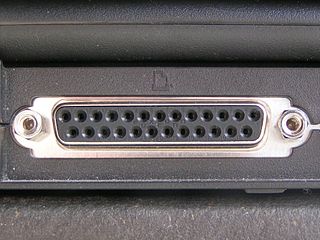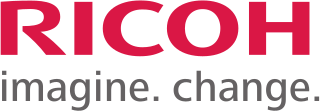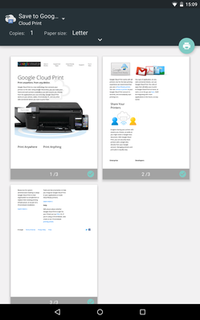Related Research Articles
In computing, a device driver is a computer program that operates or controls a particular type of device that is attached to a computer or automaton. A driver provides a software interface to hardware devices, enabling operating systems and other computer programs to access hardware functions without needing to know precise details about the hardware being used.

An operating system (OS) is system software that manages computer hardware, software resources, and provides common services for computer programs.
In digital printing, a page description language (PDL) is a computer language that describes the appearance of a printed page in a higher level than an actual output bitmap. An overlapping term is printer control language, which includes Hewlett-Packard's Printer Command Language (PCL). PostScript is one of the most noted page description languages. The markup language adaptation of the PDL is the page description markup language.
Samba is a free software re-implementation of the SMB networking protocol, and was originally developed by Andrew Tridgell. Samba provides file and print services for various Microsoft Windows clients and can integrate with a Microsoft Windows Server domain, either as a Domain Controller (DC) or as a domain member. As of version 4, it supports Active Directory and Microsoft Windows NT domains.

The LaserWriter is a laser printer with built-in PostScript interpreter sold by Apple, Inc. from 1985 to 1988. It was one of the first laser printers available to the mass market. In combination with WYSIWYG publishing software like PageMaker, that operated on top of the graphical user interface of Macintosh computers, the LaserWriter was a key component at the beginning of the desktop publishing revolution.

In computing, a parallel port is a type of interface found on early computers for connecting peripherals. The name refers to the way the data is sent; parallel ports send multiple bits of data at once, as opposed to serial communication, in which bits are sent one at a time. To do this, parallel ports require multiple data lines in their cables and port connectors and tend to be larger than contemporary serial ports, which only require one data line.
The Internet Printing Protocol (IPP) is a specialized Internet protocol for communication between client devices and printers. It allows clients to submit one or more print jobs to the printer or print server, and perform tasks such as querying the status of a printer, obtaining the status of print jobs, or cancelling individual print jobs.

CUPS is a modular printing system for Unix-like computer operating systems which allows a computer to act as a print server. A computer running CUPS is a host that can accept print jobs from client computers, process them, and send them to the appropriate printer.
In computers, a printer driver or a print processor is a piece of software on a computer that converts the data to be printed to a format that a printer can understand. The purpose of printer drivers is to allow applications to do printing without being aware of the technical details of each printer model.

The Ricoh Company, Ltd. is a Japanese multinational imaging and electronics company. It was founded by the now-defunct commercial division of the Institute of Physical and Chemical Research (Riken) known as the Riken Concern, on 6 February 1936 as Riken Sensitized Paper. Ricoh's headquarters are located in Ota, Tokyo.

LaserJet as a brand name identifies the line of laser printers marketed by the American computer company Hewlett-Packard (HP). The HP LaserJet was the world's first desktop laser printer. Canon supplies both mechanisms and cartridges for all HP's laser printers.
Print Services for UNIX is the name currently given by Microsoft to its support of the Line Printer Daemon protocol on Windows NT-based systems. It is installed using the Add/Remove Programs control panel applet. This component allows LPD queues to be supported using the native Windows printing system. It does not provide the lpr, lpq, lprm, or lpc commands.
Gutenprint is a collection of free-software printer drivers for use with UNIX spooling systems, such as CUPS, lpr and LPRng. These drivers provide printing services for Unix-like systems, RISC OS and Haiku.
Printer Command Language, more commonly referred to as PCL, is a page description language (PDL) developed by Hewlett-Packard as a printer protocol and has become a de facto industry standard. Originally developed for early inkjet printers in 1984, PCL has been released in varying levels for thermal, matrix, and page printers. HP-GL/2 and PJL are supported by later versions of PCL.
In computer networking, STREAMS is the native framework in Unix System V for implementing character device drivers, network protocols, and inter-process communication. In this framework, a stream is a chain of coroutines that pass messages between a program and a device driver. STREAMS originated in Version 8 Research Unix, as Streams.
ESC/P, short for Epson Standard Code for Printers and sometimes styled Escape/P, is a printer control language developed by Epson to control computer printers. It was mainly used in dot matrix printers and some inkjet printers, and is still widely used in many receipt thermal printers. During the era of dot matrix printers, it was also used by other manufacturers, sometimes in modified form. At the time, it was a popular mechanism to add formatting to printed text, and was widely supported in software.

AirPrint is a feature in Apple Inc.'s macOS and iOS operating systems for printing without installing printer-specific drivers. Connection is via a wireless LAN (Wi-Fi), either directly to AirPrint-compatible printers, or to non-compatible shared printers by way of a computer running Microsoft Windows, Linux, or macOS. It was originally intended for iOS devices and connected via a Wi-Fi network only, and thus required a Wi-Fi access point. However, with the introduction of AirPrint to the macOS desktop platform in 2012, Macs connected to the network via Ethernet connection could also print using the AirPrint protocol—not just those connected via Wi-Fi. Direct Wi-Fi connection between the device and the printer is not supported by default, but has appeared as the 'HP ePrint Wireless Direct AirPrint' feature.

Google Cloud Print is a discontinued Google service that allowed users to print from any Cloud Print-aware application on any device in the network cloud to any printer with native support for connecting to cloud print services – without Google having to create and maintain printing subsystems for all the hardware combinations of client devices and printers, and without the users having to install device drivers to the client, but with documents being fully transmitted to Google. Since July 23, 2013 it also allowed printing from any Windows application, if Google Cloud Printer was installed on the machine. Google Cloud Print was shut down on December 31, 2020.
HP Universal Print Driver (UPD) is an intelligent print driver that supports a broad range of HP LaserJet printers and MFPs. Developed by Hewlett-Packard, it combines a general purpose driver and HP proprietary extensions. HP UPD simplifies driver deployment and management. This advanced print driver has the ability to discover HP printing devices and automatically configure itself to the device capabilities.
References
- 1 2 Zenographics Zx-protocol comparison and overview
- ↑ "Ricoh Aficio SG2100N Linux RPCS driver « riccade". riccade.wordpress.com. Archived from the original on 2014-05-03.
- ↑ https://forum.manjaro.org/t/ricoh-original-geljet-rpcs-printer-drivers-aficio-ipsio-and-similar-sg-brands/19404 [ dead link ]
